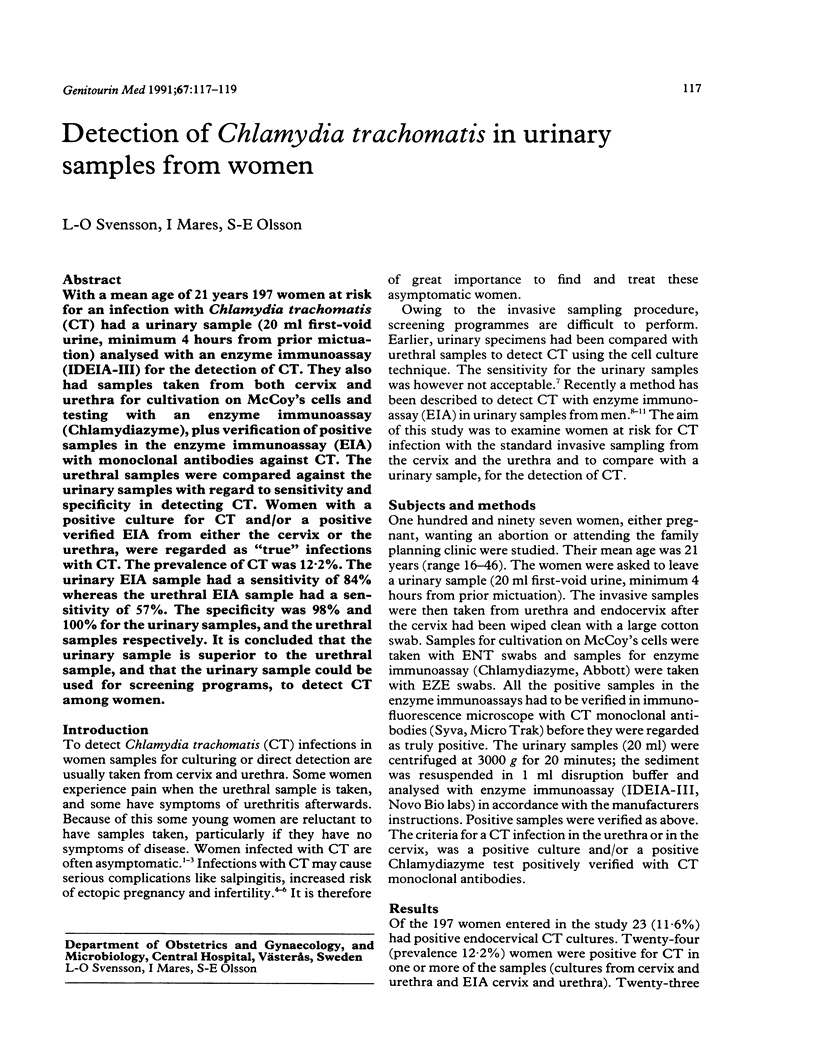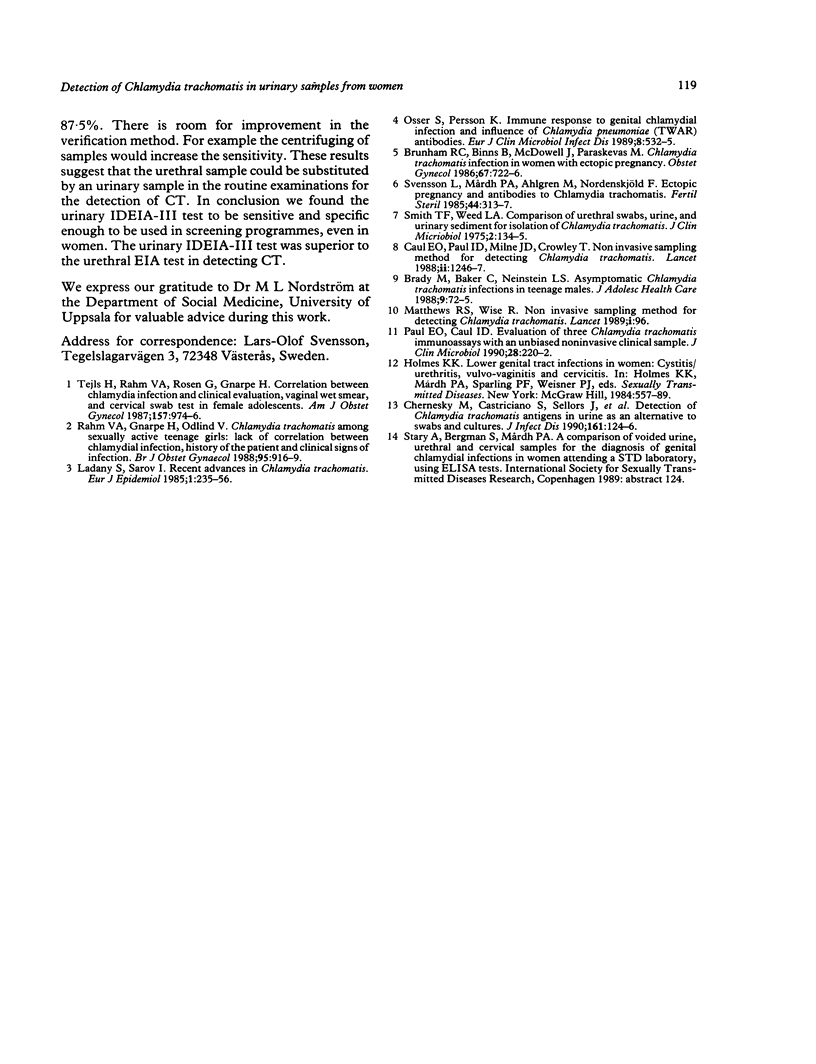Abstract
With a mean age of 21 years 197 women at risk for an infection with Chlamydia trachomatis (CT) had a urinary sample (20 ml first-void urine, minimum 4 hours from prior mictuation) analysed with an enzyme immunoassay (IDEIA-III) for the detection of CT. They also had samples taken from both cervix and urethra for cultivation on McCoy's cells and testing with an enzyme immunoassay (Chlamydiazyme), plus verification of positive samples in the enzyme immunoassay (EIA) with monoclonal antibodies against CT. The urethral samples were compared against the urinary samples with regard to sensitivity and specificity in detecting CT. Women with a positive culture for CT and/or a positive verified EIA from either the cervix or the urethra, were regarded as "true" infections with CT. The prevalence of CT was 12.2%. The urinary EIA sample had a sensitivity of 84% whereas the urethral EIA sample had a sensitivity of 57%. The specificity was 98% and 100% for the urinary samples, and the urethral samples respectively. It is concluded that the urinary sample is superior to the urethral sample, and that the urinary sample could be used for screening programs, to detect CT among women.
Full text
PDF


Selected References
These references are in PubMed. This may not be the complete list of references from this article.
- Brady M., Baker C., Neinstein L. S. Asymptomatic Chlamydia trachomatis infections in teenage males. J Adolesc Health Care. 1988 Jan;9(1):72–75. doi: 10.1016/0197-0070(88)90022-8. [DOI] [PubMed] [Google Scholar]
- Brunham R. C., Binns B., McDowell J., Paraskevas M. Chlamydia trachomatis infection in women with ectopic pregnancy. Obstet Gynecol. 1986 May;67(5):722–726. doi: 10.1097/00006250-198605000-00022. [DOI] [PubMed] [Google Scholar]
- Caul E. O., Paul I. D., Milne J. D., Crowley T. Non-invasive sampling method for detecting Chlamydia trachomatis. Lancet. 1988 Nov 26;2(8622):1246–1247. doi: 10.1016/s0140-6736(88)90831-8. [DOI] [PubMed] [Google Scholar]
- Chernesky M., Castriciano S., Sellors J., Stewart I., Cunningham I., Landis S., Seidelman W., Grant L., Devlin C., Mahony J. Detection of Chlamydia trachomatis antigens in urine as an alternative to swabs and cultures. J Infect Dis. 1990 Jan;161(1):124–126. doi: 10.1093/infdis/161.1.124. [DOI] [PubMed] [Google Scholar]
- Ladany S., Sarov I. Recent advances in Chlamydia trachomatis. Eur J Epidemiol. 1985 Dec;1(4):235–256. doi: 10.1007/BF00237099. [DOI] [PubMed] [Google Scholar]
- Osser S., Persson K. Immune response to genital chlamydial infection and influence of Chlamydia pneumoniae (TWAR) antibodies. Eur J Clin Microbiol Infect Dis. 1989 Jun;8(6):532–535. doi: 10.1007/BF01967475. [DOI] [PubMed] [Google Scholar]
- Paul I. D., Caul E. O. Evaluation of three Chlamydia trachomatis immunoassays with an unbiased, noninvasive clinical sample. J Clin Microbiol. 1990 Feb;28(2):220–222. doi: 10.1128/jcm.28.2.220-222.1990. [DOI] [PMC free article] [PubMed] [Google Scholar]
- Rahm V. A., Gnarpe H., Odlind V. Chlamydia trachomatis among sexually active teenage girls. Lack of correlation between chlamydial infection, history of the patient and clinical signs of infection. Br J Obstet Gynaecol. 1988 Sep;95(9):916–919. doi: 10.1111/j.1471-0528.1988.tb06580.x. [DOI] [PubMed] [Google Scholar]
- Smith T. F., Weed L. A. Comparison of urethral swabs, urine, and urinary sediment for the isolation of Chlamydia. J Clin Microbiol. 1976 Aug;2(2):134–135. [PMC free article] [PubMed] [Google Scholar]
- Svensson L., Mårdh P. A., Ahlgren M., Nordenskjöld F. Ectopic pregnancy and antibodies to Chlamydia trachomatis. Fertil Steril. 1985 Sep;44(3):313–317. [PubMed] [Google Scholar]
- Thejls H., Rahm V. A., Rosen G., Gnarpe H. Correlation between chlamydia infection and clinical evaluation, vaginal wet smear, and cervical swab test in female adolescents. Am J Obstet Gynecol. 1987 Oct;157(4 Pt 1):974–976. doi: 10.1016/s0002-9378(87)80098-4. [DOI] [PubMed] [Google Scholar]


